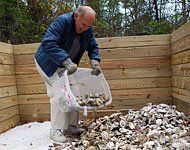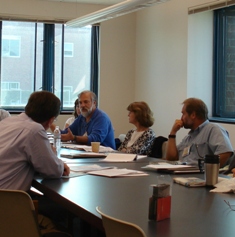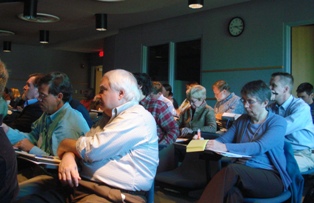|
Shellfish Restoration
Network
|
Distributed by The Nature Conservancy's Global Marine Initiative
|
Save Oyster Shells program shows promise in
Virginia
Oyster shell recycling efforts have been successful in North Carolina and South Carolina where state-managed programs secure significant quantities of shell each year for use in oyster reef restoration projects. An expanding, grass-roots based program in Virginia called “Save Oyster Shells” (SOS) is also demonstrating the potential for securing significant quantities of shells for restoration projects in the southern Chesapeake Bay. Oyster shells are the preferred substrate for swimming oyster larvae that are ready to attach to a hard surface. Reusing this valuable and limited resource is an economical solution to restoring native oyster populations, particularly in locations where populations are limited by substrate availability. In 2006 The Chesapeake Bay Foundation (CBF) initiated the “Save Oyster Shell” (SOS) recycling program to collect oyster shells for restoration projects in several tributaries to the southern Chesapeake Bay region. CBF partnered with local businesses and environmental groups throughout Hampton Roads/Tidewater region of Virginia to collect oyster shells produced by local restaurants and local citizens. The initial short-term goal of the SOS program was to collect sufficient quantities of shell to support construction of “living shorelines” where mini-reefs were used to protect shorelines. A longer-term goal of the SOS program is to develop a public awareness that shells are a valuable resource for Bay restoration and should be recycled rather than discarded in a landfill. In the pilot-phase of the program, recycled shells were supplemented by shell from oyster processing houses and used to construct the living shoreline projects in collaboration with waterfront property owners. Ten shoreline reefs were constructed with approximately 1,120 bushels of oyster shell at six locations in the Lynnhaven River and Lafayette River, two tributaries to the southern Chesapeake Bay. The pilot-phase involved at least 18 major partner organizations and approximately 150 volunteers.
In 2008 the program was expanded with funding from the Restore America’s Estuaries-NOAA Community-based Restoration Partnership. In the past six months, two long-term storage bins have been constructed (one at the Virginia Institute of Marine Science (VIMS) in Gloucester Point, VA and one in the historic section of Williamsburg, VA. Four restaurants have committed to supporting the program and additional shells have been reclaimed from several oyster roast events and various other projects. Other key partners include APVA Preservation Virginia and Aylett County Day School. Since April 2008, more than 600 bushels of shells have been secured with the expanded program. The SOS approach is simple - volunteers collect from restaurants shells that would otherwise be discarded and transported to a landfill. The restaurants are provided with lidded shell recycling bins that are marked to indicate the volume of shells accumulated between retrieval dates. Volunteers record the quantity of shells on collection days to track the volume of shells being secured from individual restaurants over time. The shell is cured on land in storage containers for several months at one of two consolidation sites to remove organic matter. It is then washed prior to being used in oyster restoration activities. The program continues to generate media attention that helps to both educate a wide audience and generate additional support for the program. Some of the equipment needs for the expanded program include materials to construct semi-permanent storage bins, collection bins for restaurants, a utility trailer for collecting shell at roasts and festivals, and stickers and signs that will help brand and promote the program. Jackie Harmon is the Virginia Oyster Restoration Specialist for the Chesapeake Bay Foundation. jharmon@cbf.org Back to top » |
|
The U.S. Army Corps of Engineers, the State of Maryland and Commonwealth of Virginia have announced their preference for increased native oyster restoration over the introduction of a non-native species of oyster to Chesapeake Bay. This decision is the culmination of a five year Programmatic Environmental Impact Study (PEIS) designed to evaluate a range of options for restoring the Chesapeake’s devastated oyster fishery and ecological function of oysters. The decision should provide closure over the question of whether the introduction of a non-native oyster species offers a viable and safe solution relative to efforts to increase the scale and sophistication of native oyster reef restoration for both fishery and ecological benefits. In a joint media release, the Chesapeake Bay Foundation and The Nature Conservancy applauded the decision. “This decision supports native oyster restoration and says no to further testing of Asian oysters unless it is conducted with no risk to the Bay,” said Roy Hoagland, CBF Vice President for Environmental Protection and Restoration. “Governors O’Malley and Kaine and Colonel Anninos have correctly recognized the dangers that non-native oysters pose as well as the enormous potential for restoration of the native population.” Over the last five years, aquaculture and native oyster restoration techniques have improved substantially, and today there are scores of profitable businesses producing native oysters grown on “oyster farms.” At the same time, wild oysters are showing increasing tolerance to diseases, and rivers such as Virginia’s Lynnhaven and Great Wicomico now have established, thriving native oyster reefs. “Restoration and aquaculture successes can and will continue to expand with our native oyster,” said Michael Lipford, Virginia Executive Director for TNC. “We look forward to working in a unified and coordinated effort with citizens, governments, and the seafood industry to ensure a healthy oyster resource and profitable native oyster economy.” More information about the decision and the Programmatic Environmental Impact Study (PEIS) can be found at the Maryland Department of Natural Resources website: http://www.dnr.state.md.us/dnrnews/infocus/oysters.asp Back to top »Putting a price tag on ecosystem services provided
by native bivalves The 2005 Millennium Ecosystem Assessment helped to introduce the term ‘ecosystem services’ into the vocabulary of many conservationists, managers and researchers. Since then there has been a proliferation of research highlighting the benefits that people derive from ecosystems such as coastal wetlands and underscoring the importance of incorporating ecosystem services into conservation efforts and resource management decisions. One of the obstacles to incorporating ecosystem services into management decisions is assigning a value or ‘price tag’ on the services provided by habitats or ecosystems. This economic value can be determined in various ways, such as ‘Willingness to Pay’ surveys of stakeholders, or from markets such voluntary programs (e.g., Forest Trends’ Chesapeake Fund) or regulatory ‘cap-and-trade’ programs designed to reduce pollution (e.g., nutrient trading markets). While the ecosystem services delivered by oysters, clams and other bivalves are relatively well-described by ecologists, the efforts to ascribe economic value to these services are still in their infancy. To help advance this topic, a two day workshop was convened at the University of Rhode Island in September 2008, to bring natural resource economists and shellfish ecologists together with the goal of identifying the kinds of services most likely to be of economic value or be conducive to being traded in markets. A public symposium was also held as part of the workshop to introduce the concepts of valuation economics, ecosystem services and shellfish ecology. In breakout group discussions, workshop participants concluded that there are several ecosystem services provided by shellfish, such as the role of shellfish in promoting denitrification (a process that removes nitrogen from estuaries and coastal waters), that may have particular economic value or could provide opportunities for developing markets that increase the demand for shellfish restoration and conservation. Building off the workshop, a subset of workshop participants were convened in a secondary meeting in March 2009 to begin summarizing the workshop findings and to develop some of the research ideas identified through the workshop discussions. A series of papers will hopefully be submitted to various peer-reviewed journals by mid-2009 that will help to advance the conservation, restoration and management of native bivalves. Workshop support was provided in part by the U.S. Environmental Protection Agency Office of Research and Development and by The National Partnership between The Nature Conservancy and NOAA Community-based Restoration Program.
Looking Ahead International
Marine Conservation Congress - Making Marine Science
Matter Coastal
and Estuarine Research Federation - Estuaries and Coasts in a
Changing World Note: If you would like to
contribute an article or submit items for the "Looking Ahead"
section, please contact Rob Brumbaugh (rbrumbaugh@tnc.org) The Practitioner’s Guide to Shellfish Restoration: An Ecosystem Services Approach, as well as back issues of the Shellfish Restoration Clamor are available online. Guidance on methods for monitoring oyster reef restoration projects is available at the Oyster Restoration Workgroup website. Cool
Video! | |||
|
|
 | ||







